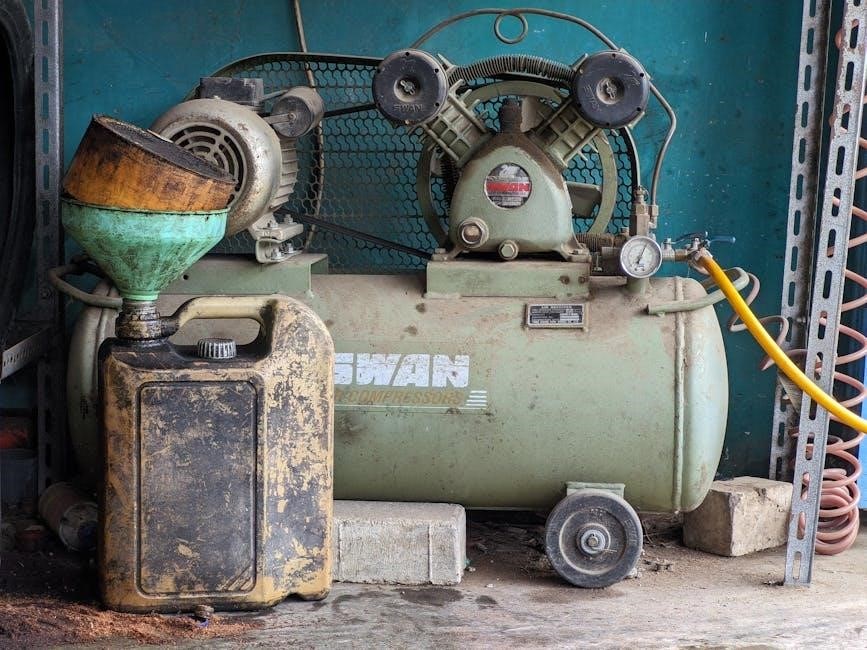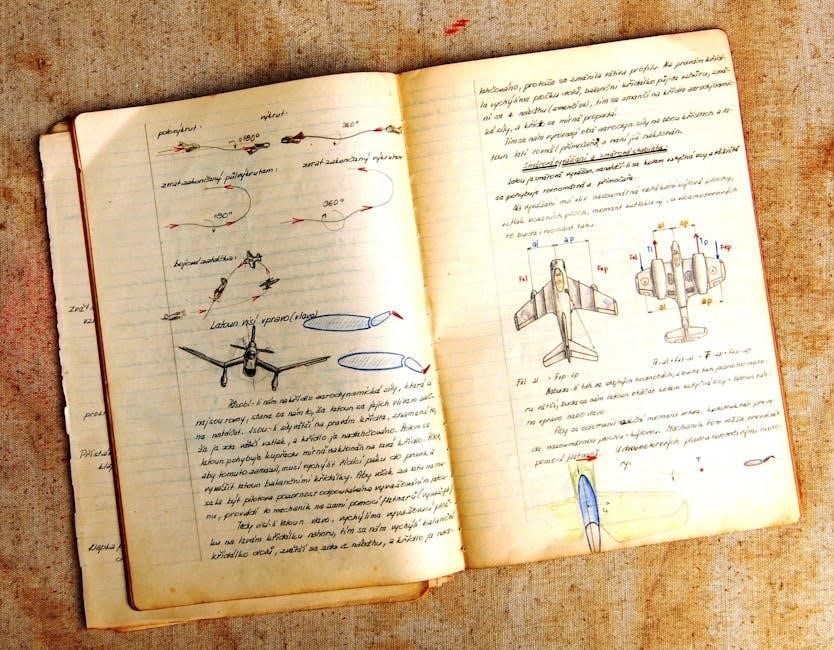Welcome to the Kaeser Compressor Manual PDF, your essential guide for understanding and maintaining Kaeser compressors․ This comprehensive resource covers installation, maintenance, and troubleshooting for models like BSD and CSDX T, ensuring safe and efficient operation․ Use original Kaeser spare parts and Sigma cooling oil for reliability․ Follow detailed instructions for optimal performance and longevity of your equipment․
Overview of Kaeser Compressors and Their Manuals
Kaeser compressors are renowned for their reliability and efficiency, catering to various industrial needs․ Their manuals provide detailed guidance for models like BSD and CSDX T, ensuring optimal performance․ These resources cover installation, maintenance, and troubleshooting, emphasizing the use of original Kaeser spare parts and Sigma cooling oil for safe operation․ The manuals also include safety protocols and environmental considerations, reflecting Kaeser’s commitment to quality and innovation․ By adhering to the guidelines, users can maximize compressor lifespan and ensure compliance with international standards․ Kaeser’s dedication to user-centric solutions makes their manuals indispensable for professionals seeking seamless compressor management and energy-efficient workflows․
Importance of Using the Kaeser Compressor Manual
The Kaeser Compressor Manual is an essential resource for ensuring safe, efficient, and reliable operation of your compressor․ It provides detailed instructions for installation, maintenance, and troubleshooting, helping users avoid costly errors and downtime․ By following the manual, you can ensure compliance with safety standards and optimize performance․ The guide emphasizes the use of original Kaeser spare parts and Sigma cooling oil, which are critical for maintaining compressor reliability․ Additionally, it outlines procedures for handling compressed air safely and addressing error codes, ensuring quick resolution of issues․ Adhering to the manual’s guidelines not only extends the lifespan of your equipment but also minimizes risks to people and the environment, making it a vital tool for professionals seeking optimal results․

Key Features of the Kaeser Compressor Manual
The manual offers comprehensive maintenance procedures, detailed instructions for screw compressor models like BSD and CSDX T, and guidelines for safe operation․ It emphasizes using original Kaeser spare parts and Sigma cooling oil for reliability․
Comprehensive Maintenance Procedures
The Kaeser Compressor Manual provides detailed maintenance procedures to ensure optimal performance and longevity․ Daily checks include monitoring oil levels, filter condition, and belt tension․ Weekly tasks involve inspecting air intake filters and cleaning them if necessary․ Monthly maintenance includes replacing air and oil filters, as well as checking for leaks in the system․ Annual servicing requires a thorough inspection of the compressor’s internal components, such as the screw elements and cooling system․ The manual also outlines procedures for replacing consumable parts, like oil and filter elements, ensuring they meet Kaeser’s quality standards․ By following these guidelines, users can maintain their compressors efficiently, preventing downtime and ensuring reliable operation․ Regular maintenance is crucial for sustaining energy efficiency and overall system health․
Detailed Instructions for Screw Compressor Models (e․g․, BSD, CSDX T)
The Kaeser Compressor Manual provides specific guidance for screw compressor models like BSD and CSDX T, tailoring instructions to their unique requirements․ For the BSD model, the manual outlines installation, daily checks, and maintenance procedures to ensure smooth operation․ For the CSDX T series, detailed step-by-step instructions cover oil change intervals, filter replacements, and belt tension adjustments․ The manual also includes troubleshooting tips for common issues, such as abnormal noise or temperature fluctuations․ Additionally, it provides diagrams and tables for understanding system components and performance parameters․ By following these detailed instructions, users can optimize the efficiency and lifespan of their screw compressors․ The manual emphasizes the importance of using original Kaeser spare parts and Sigma Control 2 for monitoring and control, ensuring reliable operation and compliance with safety standards․
Guidelines for Safe and Reliable Operation
The Kaeser Compressor Manual emphasizes the importance of following safety guidelines to ensure reliable operation․ Always use original Kaeser spare parts and Sigma cooling oil to maintain performance and longevity․ Before starting the compressor, inspect all components, including hoses, belts, and filters, for damage or wear․ Ensure the operating environment is clean, well-ventilated, and free from flammable materials․ Adhere to the recommended pressure limits and operating temperatures to prevent overloading․ Regularly check oil levels and replace them as per the manual’s schedule․ Familiarize yourself with emergency shutdown procedures and keep safety devices accessible․ Proper handling of compressed air is crucial to avoid accidents․ By following these guidelines, you can ensure safe, efficient, and consistent operation of your Kaeser compressor while minimizing risks to personnel and equipment․
Use of Original Kaeser Spare Parts and Sigma Cooling Oil
The Kaeser Compressor Manual strongly recommends using only original Kaeser spare parts and Sigma cooling oil to ensure safe, efficient, and reliable operation․ These components are specifically designed to meet the compressor’s technical specifications, guaranteeing optimal performance and longevity․ Using non-genuine parts or alternative oils can lead to reduced efficiency, increased wear, and potential system failure․ Always refer to the manual for guidance on selecting the correct spare parts and lubricants․ The use of original Kaeser products also ensures compliance with safety standards and warranty conditions․ For maintenance or repairs, consult the detailed parts list provided in the manual to identify the correct replacements․ This practice minimizes downtime and ensures your compressor operates at its best capacity․

Safety Guidelines and Precautions
Adhere to safety guidelines for compressor operation, ensuring proper handling of compressed air and emergency shutdown protocols to prevent accidents and maintain a secure working environment․
General Safety Instructions for Compressor Operation
Always follow safety guidelines to ensure safe and reliable operation of your Kaeser compressor․ Wear protective gear, including safety glasses and gloves, when working near the unit․ Ensure proper ventilation in the area to prevent the accumulation of compressed air or coolant vapors․ Regularly inspect hoses, pipes, and connections for signs of wear or damage․ Avoid exposing the compressor to extreme temperatures or moisture․ Keep loose clothing and long hair tied back to prevent entanglement in moving parts․ Never operate the compressor near open flames or sparks․ Follow all startup and shutdown procedures as outlined in the manual․ Be prepared for emergencies by understanding shutdown protocols and alarm systems․ Refer to the manual for specific safety instructions tailored to your compressor model․
Handling Compressed Air Safely
Always handle compressed air with caution to prevent accidents and ensure safe operation․ Ensure all components, including hoses, pipes, and fittings, are rated for the compressor’s maximum pressure․ Never exceed the recommended pressure limits․ Use only approved equipment and accessories designed for compressed air systems․ Regularly inspect piping and connections for leaks or damage․ Avoid directing compressed air at people or animals, as it can cause serious injury․ Never use compressed air to clean clothing or skin, as it may lead to physical harm․ Ensure proper drainage of moisture from the system to prevent damage or contamination․ Always follow the manufacturer’s guidelines for compressed air applications and adhere to local safety regulations․ Proper handling ensures a safe working environment and optimal compressor performance․ Use only Kaeser-approved parts to maintain system integrity and safety․

Emergency Procedures and Shutdown Protocols
In case of an emergency, activate the emergency stop button immediately to shut down the compressor․ Always disconnect the power supply before performing any maintenance or repairs․ Ensure the system is depressurized and vented safely to avoid residual pressure hazards․ Evacuate the area if there is a risk of gas leaks or other hazards․ Contact authorized Kaeser service personnel for assistance in critical situations; Keep emergency contact information readily available․ Follow the detailed shutdown procedures outlined in the manual to prevent damage or injury․ Regular training on emergency protocols is essential for safe operation․ Always refer to the Kaeser Compressor Manual for specific instructions tailored to your model․ Proper adherence ensures safety and prevents potential risks․ Use only Kaeser-approved parts and Sigma cooling oil for reliable operation․ Adhere to all safety guidelines during emergencies to protect personnel and equipment․

Installation and Setup Instructions
Ensure a stable base for the compressor unit and follow manual guidelines for physical installation․ Connect electrical components according to specified voltage requirements․ Perform initial startup and testing procedures carefully, adhering to safety guidelines․ Consult the manual for detailed setup instructions and troubleshooting tips to ensure proper operation․
Physical Installation of the Compressor Unit
Proper physical installation is crucial for the compressor’s performance and longevity․ Ensure a stable, level base to prevent vibration and misalignment․ Anchoring the unit securely to the floor is essential, following the manual’s guidelines․ Maintain adequate spacing around the compressor for ventilation and maintenance access․ Ensure the installation site is dry, free from extreme temperatures, and protected from contaminants․ Use Kaeser-approved materials for anchoring to avoid damage․ Refer to the manual for specific weight distribution and leveling instructions․ Proper installation ensures safe operation, reduces wear, and prevents potential hazards․ Always follow the manufacturer’s recommendations for physical placement and securing the unit․

Electrical Connections and Voltage Requirements
Proper electrical connections are critical for safe and efficient compressor operation․ Ensure the power supply matches the unit’s voltage requirements, typically 380V, 460V, or 220V, depending on the model․ Use a qualified electrician to connect the compressor, following local electrical codes and safety standards․ Verify the phase sequence (e․g․, three-phase AC) to avoid motor damage․ The compressor must be grounded correctly to prevent electrical hazards․ Check the manual for specific voltage configurations and wiring diagrams․ Avoid using undersized cables, as this can cause voltage drops and overheating․ Ensure the electrical supply is stable and within the recommended tolerance to maintain reliable operation․ Always refer to the manual for detailed instructions on electrical connections and voltage compatibility․ Proper installation ensures safety and prevents potential electrical risks․ Adhere to these guidelines for optimal performance and longevity of the compressor unit․
Initial Startup and Testing Procedures
Before initial startup, ensure all electrical and mechanical connections are secure and correctly configured․ Refer to the manual for specific startup instructions tailored to your compressor model․ Activate the unit and monitor its performance using the Sigma Control 2 system․ Check oil levels and ensure proper lubrication is maintained․ Test safety features, such as emergency shutdown and pressure relief valves, to confirm they function correctly․ Conduct a leak test on all connections to prevent air loss․ Allow the compressor to run under load to evaluate its performance and verify that it operates within specified parameters․ Monitor temperature, pressure, and vibration levels during the test phase․ Address any anomalies promptly to ensure reliable operation․ Document the startup process and test results for future reference and maintenance planning․ Proper initial testing ensures longevity and efficiency of the compressor unit․

Maintenance and Servicing
Regular maintenance ensures optimal performance and longevity of Kaeser compressors․ Follow daily, weekly, and monthly schedules for tasks like filter replacements and lubrication checks․ Use genuine Kaeser parts․
Daily Maintenance Tasks
Daily maintenance is crucial for ensuring the optimal performance of Kaeser compressors․ Begin by checking the oil level in the compressor and topping it up if necessary․ Inspect the air filter for cleanliness and replace it as needed to prevent airflow restrictions․ Drain any accumulated condensate from the air receiver and intercooler to avoid corrosion․ Check the drive belt for proper tension and wear, adjusting or replacing it if required․ Monitor the compressor’s temperature to ensure it operates within safe limits․ Additionally, verify the pressure gauge readings and ensure all valves are functioning correctly․ Always use genuine Kaeser spare parts for replacements to maintain reliability․ Documenting these tasks helps track maintenance history and ensures compliance with safety standards․ Regular checks prevent unexpected downtime and extend the compressor’s lifespan, ensuring efficient operation and minimal wear․
Weekly and Monthly Maintenance Schedules
Weekly maintenance involves checking the compressor controller for error messages and ensuring proper lubrication of moving parts․ Inspect the cooling system, including fans and heat exchangers, to ensure optimal performance․ Clean or replace air filters as needed to maintain airflow efficiency․ For monthly tasks, replace the oil filters and check the compressor oil quality․ Inspect the drive belts for wear and tighten if necessary․ Additionally, examine the hoses and connections for leaks or damage․ Regularly cleaning the compressor unit and surrounding area prevents dust buildup․ Always refer to the Kaeser Compressor Manual PDF for specific schedules tailored to your model․ Adhering to these routines ensures consistent performance, reduces downtime, and prolongs equipment lifespan․ Proper documentation of these tasks aids in tracking maintenance history and compliance with safety standards․
Replacing Consumable Parts and Filters
Regular replacement of consumable parts and filters is crucial for maintaining the efficiency and longevity of your Kaeser compressor․ Always use genuine Kaeser spare parts and Sigma cooling oil to ensure reliable operation․ Air filters should be cleaned or replaced weekly, while oil filters must be changed every 1,000 to 2,000 operating hours, depending on usage․ Inspect and replace drive belts annually or as needed․ Drain condensate from the compressor and coolant system regularly to prevent corrosion․ Refer to the Kaeser Compressor Manual PDF for specific replacement schedules and procedures․ Properly dispose of used filters and parts to minimize environmental impact․ Timely replacements prevent premature wear, reduce downtime, and maintain optimal performance․ Always disconnect power before performing any maintenance to ensure safety․

Troubleshooting Common Issues
Troubleshooting common issues involves diagnosing faults, addressing error codes, and repairing leaks․ The manual provides detailed procedures to resolve operational problems efficiently and safely․
Identifying and Diagnosing Compressor Faults
Identifying and diagnosing compressor faults is crucial for maintaining optimal performance․ The manual provides detailed error codes and alarm messages to help pinpoint issues quickly․ By referencing these codes, users can understand the root cause of malfunctions, such as overheating, low pressure, or oil level discrepancies․ Visual inspections and diagnostic tools are recommended to verify faults․ Regular maintenance schedules and logs can also help identify patterns or recurring problems․ Early detection of issues prevents costly repairs and downtime․ The manual emphasizes the importance of addressing faults promptly and using genuine Kaeser spare parts to ensure reliability․ Proper diagnostic techniques are outlined to guide users through troubleshooting effectively․
Addressing Error Codes and Alarms
The Kaeser Compressor Manual PDF provides clear guidance for addressing error codes and alarms, ensuring prompt resolution of issues․ Error codes such as E001 (low oil level) or E002 (high discharge temperature) are explained in detail, along with step-by-step instructions for resetting alarms and resolving underlying causes․ Users are advised to consult the manual immediately upon encountering an error to avoid further damage․ Specific troubleshooting procedures, such as checking oil levels or inspecting coolant systems, are outlined to help users identify and resolve faults efficiently․ Always use genuine Kaeser spare parts and follow recommended procedures to ensure safe and reliable operation․ Timely action is crucial to prevent downtime and maintain compressor performance․
Repairing Leaks and Optimizing Performance
Repairing leaks and optimizing performance are critical for maintaining the efficiency and longevity of your Kaeser compressor․ The manual provides detailed steps to identify and fix leaks in hoses, connections, and seals․ Regular inspections and timely repairs prevent air loss and reduce energy consumption․ For optimal performance, ensure all filters are clean and replace them as recommended․ Additionally, monitor operating parameters such as pressure, temperature, and oil levels to avoid overload․ Adjust settings as needed to match workload demands․ Always use original Kaeser spare parts and Sigma cooling oil to maintain reliability․ By following these guidelines, you can enhance performance, reduce downtime, and extend the life of your compressor․ Proper maintenance ensures safe and efficient operation․ Regular checks and prompt repairs are essential for sustained productivity․

Downloading the Kaeser Compressor Manual PDF
Access the official Kaeser website or authorized distributors for the manual․ Follow the download steps provided, ensuring the file is genuine․ Verify authenticity before use․
Official Sources for the Manual
The Kaeser compressor manual PDF is available through official channels to ensure authenticity․ Visit the Kaeser Kompressoren website or contact authorized distributors․ Documentation, including brochures and technical manuals, can be downloaded directly․ Additionally, registered users can access exclusive resources․ For press materials, a dedicated section is provided․ Verify the source to avoid counterfeit documents․ Always refer to Kaeser’s official platforms for reliable information and updates․
Steps to Download the PDF Version
To download the Kaeser compressor manual PDF, visit the official Kaeser Kompressoren website․ Navigate to the “Downloads” or “Resources” section․ Search for your specific compressor model, such as BSD or CSDX T, using the search bar․ Locate the PDF manual and click the download link․ Ensure the source is authentic to avoid counterfeit documents․ If prompted, log in to your Kaeser account or create one․ Once downloaded, verify the manual’s authenticity by checking the Kaeser logo and copyright information․ For the latest updates, check the publication date․ Always download from official channels to ensure you receive the correct and up-to-date manual․
Verification of Manual Authenticity
To ensure the Kaeser compressor manual PDF is authentic, verify the document’s copyright notice, which should clearly state “KAESER KOMPRESSOREN” as the copyright holder․ Check for the Kaeser logo and official contact information, including addresses of agents listed at the end of the manual․ Genuine manuals feature specific watermarks and professional formatting․ Be cautious of unofficial sources, as counterfeit documents may lack critical details or contain errors․ Ensure the manual includes sections on maintenance, safety, and original spare parts, as these are standard in authentic Kaeser publications․ Always download from Kaeser’s official website or authorized distributors to guarantee accuracy and reliability․

Additional Resources and Support
Kaeser offers extensive support, including online documentation, software tools, and contacts for authorized agents․ Utilize these resources for comprehensive guidance and assistance with your compressor operations and maintenance․
Contacts of Kaeser Agents and Representatives
For assistance, contact Kaeser agents or representatives listed in the manual or visit their official website․ Regional offices provide localized support, ensuring prompt service and genuine parts․ Addresses and contact details are included in the manual, making it easy to reach authorized personnel for inquiries, repairs, or spare parts․ Utilize these resources to maintain your compressor’s performance and longevity․ Always verify the authenticity of contacts to avoid unauthorized support․ This ensures safe and reliable operation, aligning with Kaeser’s commitment to quality and customer satisfaction․
Online Documentation and Software Tools
Kaeser offers extensive online documentation and software tools to enhance compressor management․ The official website provides downloadable brochures, manuals, and technical guides for models like Sm11 and BSD․ Software tools, such as Sigma Control 2, enable remote monitoring and control of compressor operations․ These resources help optimize performance, troubleshoot issues, and ensure compliance with maintenance schedules․ Additionally, online platforms offer detailed troubleshooting guides and spare parts catalogs, streamlining repair processes․ Utilize these digital tools to access real-time data, reduce downtime, and improve efficiency․ Kaeser’s online support ensures users have everything needed to maintain and enhance their compressor systems effectively, aligning with Industrie 4․0 integration for advanced management capabilities․
Kaeser Life Cycle Management and Industrie 4․0 Integration
Kaeser’s Life Cycle Management ensures optimal compressor performance throughout its lifecycle, from installation to retirement․ This approach integrates advanced Industrie 4․0 technologies, such as IoT-enabled sensors and predictive analytics, to enhance efficiency and reliability․ The Sigma Control 2 system, for instance, allows real-time monitoring and control of compressor operations, enabling proactive maintenance and energy optimization․ By leveraging data-driven insights, users can reduce downtime and operational costs․ Kaeser’s commitment to innovation aligns with Industrie 4․0 standards, offering integrated solutions that streamline compressor management․ This holistic approach not only extends equipment longevity but also supports sustainable manufacturing practices, ensuring Kaeser remains at the forefront of industrial compressor technology and customer satisfaction․
The Kaeser Compressor Manual PDF is an indispensable resource for ensuring optimal performance, safety, and efficiency․ By adhering to its guidelines, users can maintain reliability and extend equipment lifespan․
Final Thoughts on the Importance of the Manual
The Kaeser Compressor Manual PDF is a vital tool for operators and technicians, offering detailed insights into compressor operation, maintenance, and troubleshooting․ It ensures compliance with safety standards, optimizes performance, and extends equipment lifespan․ By following the manual’s instructions, users can prevent costly errors and downtime, ensuring efficient compressed air production․ The manual’s comprehensive nature makes it an essential companion for anyone working with Kaeser compressors, fostering a culture of safety and operational excellence․ Regularly referencing this guide guarantees seamless integration of best practices, ultimately enhancing productivity and reliability in industrial settings․
Encouragement to Follow Guidelines for Optimal Performance
Adhering to the Kaeser Compressor Manual PDF is essential for achieving optimal performance and reliability․ By following the outlined instructions, users can ensure efficient operation, reduce downtime, and extend the lifespan of their equipment․ The manual provides clear, step-by-step guidance for maintenance, troubleshooting, and safe practices, all of which are critical for maximizing productivity․ Regularly referencing the manual helps operators avoid costly errors and maintain compliance with safety standards․ Encourage your team to make the Kaeser Compressor Manual their go-to resource for all operational needs․ This commitment to following guidelines will not only enhance performance but also foster a safer and more efficient working environment․
